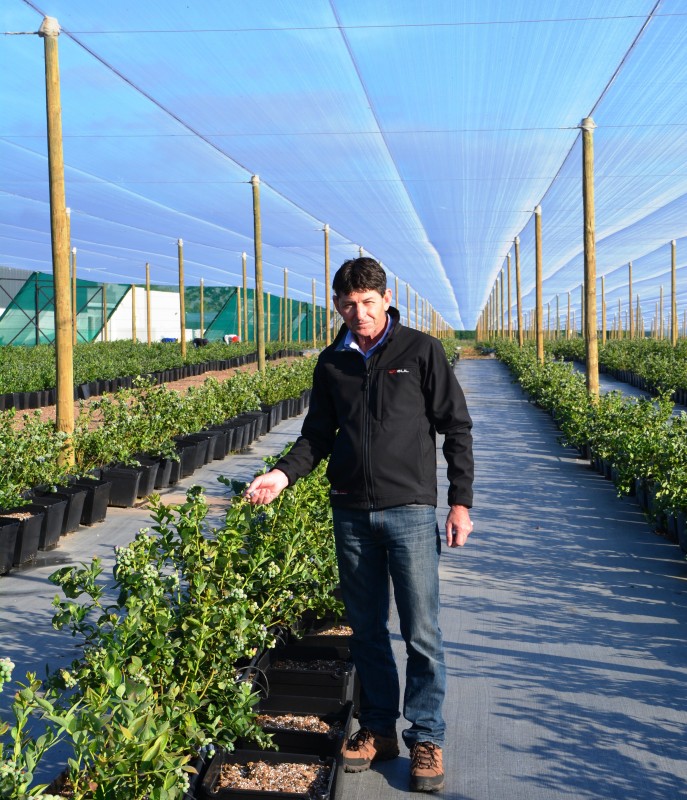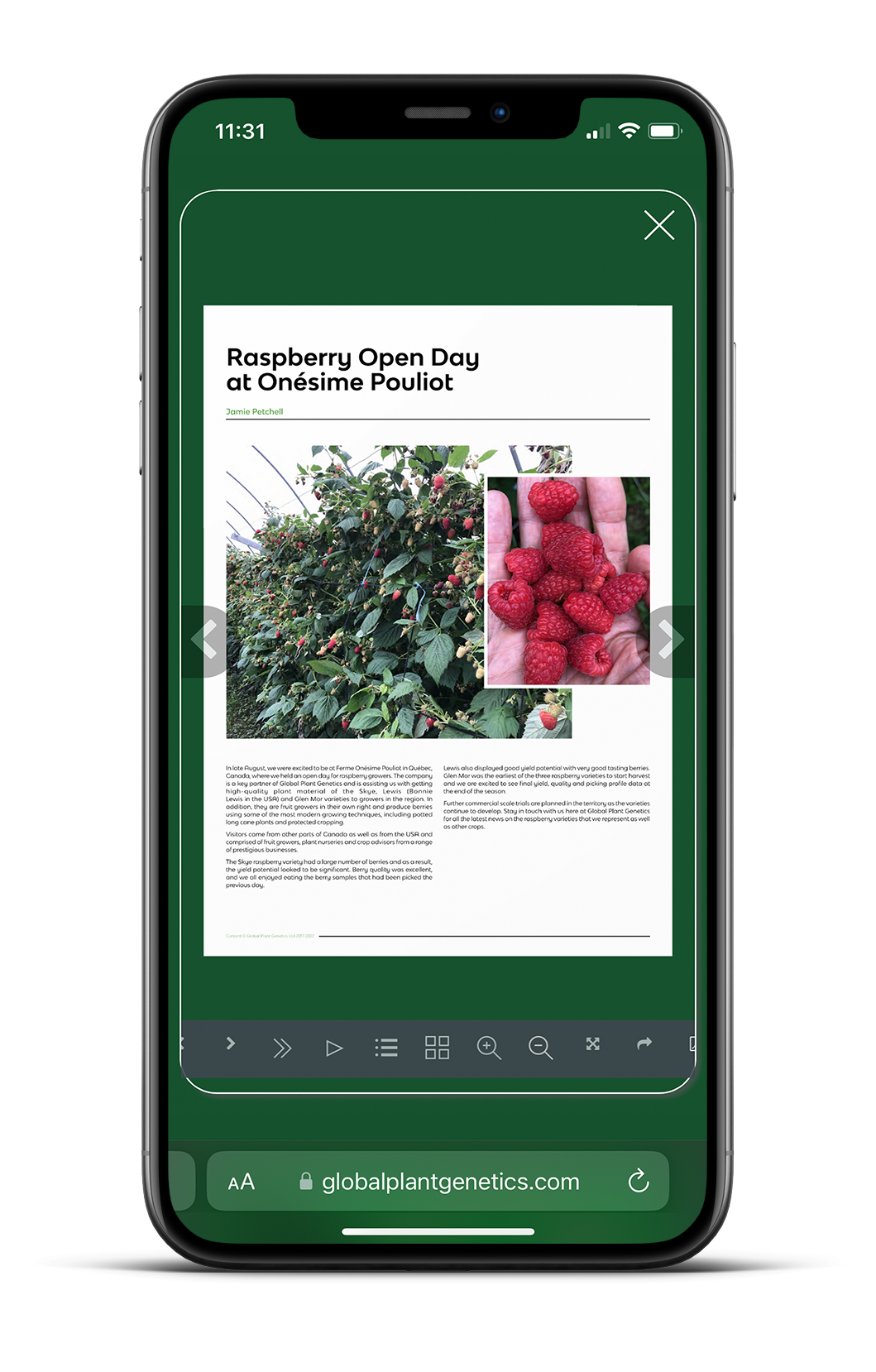MG: Which quality traits are you particularly looking for in the selections that you make for Southern Africa?
PZ: Fruit quality is of utmost importance to TopFruit. Berries should be firm and able to ship well. In terms of firmness, we look for a crunchy pop sensation when the berries are eaten rather than a fibrery berry with a grainy texture. Taste is important and although most markets focus on a sweet tangy taste, we also look for alternative flavours that would make a specific variety stand out from the rest. We do not particularly select for very large berries as the majority of markets and consumers are satisfied with a decent fruit size of 14-25mm. Appearances such as a good bloom and a clean fresh look are also important.
MG: How adaptable are you finding the selections to your various growing regions?
PZ: South Africa has different climate regions with the Western Cape region that has a Mediterranean climate to the North that is more sub-tropical with a summer rainfall. The primary focus is on low to very low chill varieties suitable for these regions. Then evergreen types are also selected for other Southern African countries such as Zambia and Kenya where no chill conditions prevail. It is always a challenge to choose selections that you evaluate in a climate zone such as the state of Georgia, USA and then try to decide how it will perform in a completely different environment. We have to look at certain genetic appearances and traits of what are available and make a choice of a number of selections to trial in the different regions in Southern Africa to decide which ones work the best for us. Over the past five years we have identified a core of varieties that are highly suitable and this information would be of value to other countries with similar constraints.
MG: Plant quality is highly important, what steps have you taken to ensure premium quality plants are delivered?
PZ: TopFruit has worked closely with Vitroplant SA nursery and they are responsible for the multiplication of our varieties. All plants are made from tissue culture and then hardened off in 1L pots. We also use the expertise of a Dutch consultant to ensure that the correct operational procedures are followed. A healthy plant with a strong root system can give a grower 1.7kg per plant within the first year of planting in containers.
MG: Working with GPG, you have had the opportunity to hand pick a number of blueberry varieties to commercialise in Southern Africa. Could you give us a brief summary on what you think of the Duchess series and the Blue Angel series?
PZ: What we prefer in South Africa is a medium to very low chill, early bearing variety. The ideal is to be as early as June and be done with the crop by end of October in the North and by November in the cooler regions. Sweet Duchess and Maverick are ideal for these requirements with Early Duchess which produces large early primocane fruit that is also good variety to compliment the others. Blue Duchess is a mid-chill variety for cooler regions that produces very good quality fruit with excellent eating quality. This variety is a natural strong upright grower and needs more manipulating to produce a large crop as it is a tip bearer. The other newcomer is Gladiator that shows very good results in the trial sites. This is a more dwarfing plant that is very precocious and bears large fruit of very good quality. As we do not select varieties for machine-harvesting, we are looking for a more open spreading bush and some selections that are vigorous upright growers are not preferred in our region.
MG: Obviously, grower viewpoints are important when bringing new varieties to market but what feedback have you had from the Packers and Retailers?
PZ In general we had favourable feedback from the marketers. The earliness as well as fruit quality of the Sweet Duchess made it a favourite. However, there were some complaints of the flower end of the fruit that has a russet ring especially in regions where cold, rainy conditions were present early on in the flowering stage. Sweet Duchess fruit had an average brix of 12-14, with Durofel firmness readings of 80-85 and average size of 14-22mm. Bloom was good and overall eating sensation put it on the preferred list of some supermarkets. Blue Duchess has very clean looking fruit with an excellent bloom, it eats well and has a sweet, tangy taste with brix at 12-15. Fruit size averaged at 14 to 24mm and average 80 on the Durofel measures. Early Duchess has very early primocane fruit which were very big 18-25mm which ate well and were firm. Later floricane fruit were somewhat inconsistent in size, flavour and firmness. Maverick had medium to large sized fruit of 14-20mm, firm berries of 75-85 Durofel pressures and brix of 11.5 – 13. All these varieties shipped well.
MG: If you had to choose 3 varieties that could well be global superstars from this programme, which 3 would you choose.
PZ: The growers’ favourite up to a year ago certainly was Sweet Duchess. This is a very low chill variety that produces very early fruit of excellent quality. It has an excellent production possibility and 20 tons per hectare can be reached within three years of planting. It is a very open, spreading bush with limited manipulation needed. Secondly, Maverick has shown in a very short period that it is also a winner. It is a strong vigorous grower that feathers naturally and produces an abundance of laterals with a rapid onset of flowers. This variety flowers very early, but harvest is about three weeks later than Sweet Duchess. Fruit quality is good and although fruit is medium to large size, it bears prolifically. It is also suitable for warm, no chill regions such as Zambia and Kenya. Thirdly, Gladiator as mentioned did very well in our trial sites. It’s a more dwarfing grower and produces early to mid-season fruit. It is very precocious with an abundance of flower buds all the way down the shoots. It has a short, condensed harvest period and produces large fruit of excellent quality. The fruit is very firm, sweet and good looking. Gladiator also did very well in our trial site in Zambia. All three of these varieties are ideal for soil and container planting.
Beyond what we have commercialised to date, we have a number of advanced selections in trial and many more on the way. This pipeline will undoubtably create further benefits and opportunities for our growers in the future concluded Pieter.

